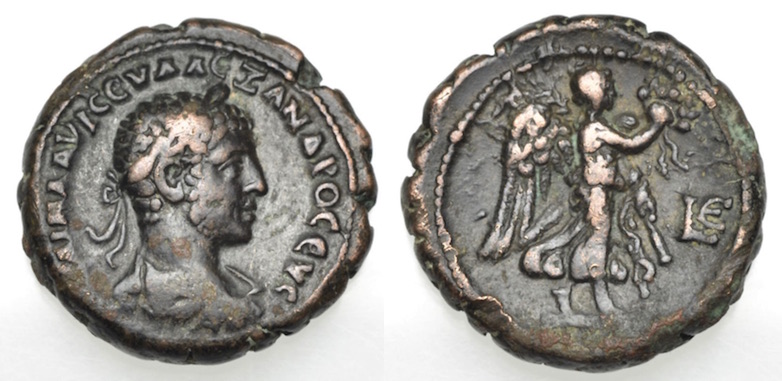 Severus Alexander (Roman Emperor, AD 222-235)
Severus Alexander (Roman Emperor, AD 222-235)"Year 5" coins for Alexandria, Egypt
 Severus Alexander (Roman Emperor, AD 222-235)
Severus Alexander (Roman Emperor, AD 222-235)
"Year 5" coins for Alexandria, Egypt
Year 5 (AD 225/6) is particularly interesting because there are Alexandrian year 5 coins for Severus Alexander from two different years and two different mints. Read on to find out how that can be.
"Year 5" tetradrachms for Alexandria in the name of Severus Alexander come in three categories
1) the usual Alexandrian style, issued from Alexandria using his regnal year date written "LE" (the first coin, to the right),
2) "Roman style," larger, with regnal year spelled out "LΠEMΠTOY", and struck at the Rome mint for use in Egypt (the second coin, next).
and
3) the usual Alexandrian style, issued from Alexandria for Severus Alexander in year 5 of Elagabalus when Severus Alexander was Caesar (the third coin).
Above right. The coin at the top right is a "year 5" tetradrachm for Severus Alexander minted at Alexandria . It is "normal," as opposed the others shown below. The reverse shows Nike (Victory) walking right holding wreath and palm branch, with LE in the right field, where "L" is the Egyptian symbol for "year" and E is 5 in Greek.
A KAI M AVP CEV AΛEΞANΔPOC EVC
Autokrater (Imperator) KAI[sar] (Caesar) Marcus AURelius SEVerus ALEXANDERVS EUC[ebeus] (Pius)
23 mm. 12.1 grams. Emmett 3115 ( "Nike flying right").
What's new? 2022, Oct. 7. Speculation about why they were issued.
Coins of Roman Egypt were minted at Alexandria and dated by the regnal year of the emperor, with the new year beginning on what we call August 29 and the old one ending on August 28. Severus Alexander became emperor on March 6, 222, so he had almost seven months as "year 1" before year 2 began. His year 5 is 225/6, that is August 29, 225 through Augustus 28, 226.
 Roman style. The style and size of the next one is different (The photo is to scale). It is also a tetradrachm of year 5, but 26 mm instead of only 23 mm--it is significantly broader and much thinner. The portrait looks like his portraits on imperial coins, not those on Alexandrian coins, and "year 5" is written out as L ΠEMΠTOY. L is again the Egyptian symbol for "year" and ΠEMΠTOY is "fifth".
Roman style. The style and size of the next one is different (The photo is to scale). It is also a tetradrachm of year 5, but 26 mm instead of only 23 mm--it is significantly broader and much thinner. The portrait looks like his portraits on imperial coins, not those on Alexandrian coins, and "year 5" is written out as L ΠEMΠTOY. L is again the Egyptian symbol for "year" and ΠEMΠTOY is "fifth".
The type is Serapis (an Egyptian god, distinguished by the modius on his head) standing left, raising his right hand, and holding transverse long scepter. The obverse legend is long:
A KAI M AVP CEOVHR AΛEΞANΔPOC EVCEB
Imperator Caesar Marcus AURelius SEVERUs ALEXANDERVS Pius
26-24 mm. 13.55 grams. Emmett 3134
The coin was struck for Alexandria, but with dies of Roman style and struck in Rome. There are only a few occasions when the Rome mint struck coins in Greek as if they were struck at a regional mint. The argument for this is below after the third distinct "year 5" group of tetradrachms from a different year.
A Different Year. The next one again says "year 5" but it is a different year!
Severus Alexander looks younger on this coin. That's because he is. On this coin he is only "Caesar" under Elagabalus and not yet Augustus, so his coin uses the regnal year 5 of Elagablus (218-22), not his own regnal year as on the coins above.

Severus Alexander as Caesar, year 5 of Elagabalus (AD 221/2)
23-22 mm. 12.97 grams.
Athena standing left, holding Victory, resting left hand on shield
LE in field left.
MAP AYP AΛEΞANΔPOC KAICAP
Emmett 3006. Sear 2.8109. Struck at Alexandria.
Observations. Tetradrachms from Roman Egypt minted at Alexandria are thick compared to Roman imperial coins. They have the "fabic" (shape, size, and metal quality) of the first and third coins above. The second coin above, from Rome, is distinct in size, fabric, style, and legend. For comparison, here are four coins--another Alexandrian year-5 piece, another Rome year-5 piece and two imperial Roman portrait pieces.
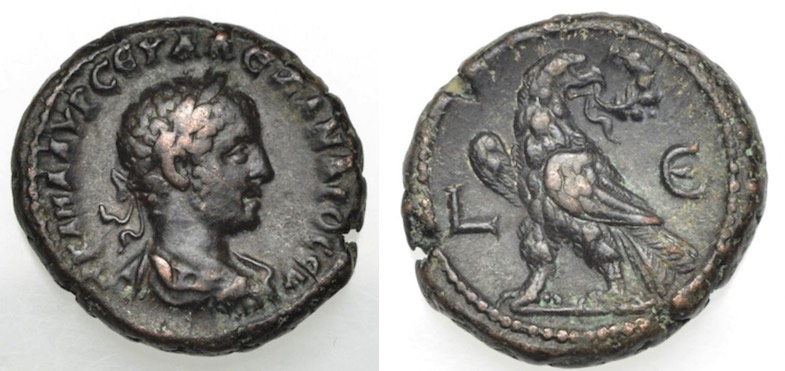
Another "year 5" (LE) as Augustus from the Alexandria mint, this one with an eagle left with head turned back to the right, with a wreath in its beak. The portrait style is consistent with the style of other coins minted in Alexandria.
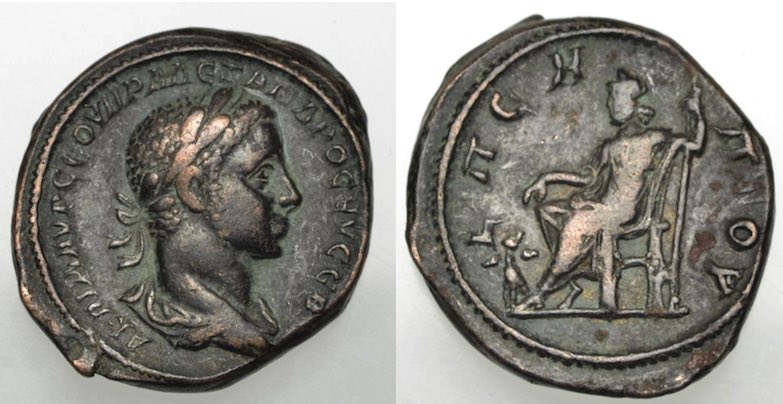
This type has Serapis seated (instead of standing) but it is otherwise very much like the Rome mint coin above. Ceberus (the three-headed dog) is at his feet left.
L ΠEMΠTOY spells out the year (year, fifth). Again, the portrait style is Roman and the size is 26 mm.
Emmett 3135. 11.08 grams.
Compare the style to the next two coins struck in Rome, a denarius from 227 and an as from 228.
 An imperial silver denarius from the Rome mint, struck 227 ("year 5" begins in 225).
An imperial silver denarius from the Rome mint, struck 227 ("year 5" begins in 225).IMP C M AVR SEV ALEXAND AVG
PM TRP VI COS II PP [He was TRP VI in AD 227]
Mars, helmeted, walking right with spear in right and trophy over his left shoulder.
20-18 mm. RIC 85 Sear 7906
Compare the portraits.
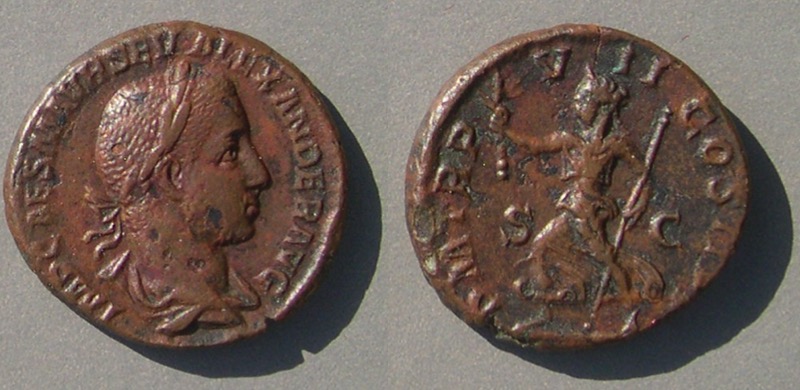
An imperial copper as from the Rome mint, struck 228 ("year 5" ends in 226).
IMP CAES M AVR SEV ALEXANDER AVG
PM TRP VII COS II [He was TRP VII in AD 228]
Pax advancing left holding branch and scepter, S C across field
24 mm. RIC 480.
Clearly the larger tetradrachms with Roman style are different from the usual Alexandrian mint tetradrachms and they have some connection with the mint of Rome. At the very least they are "Struck from dies of 'Roman' style" [Sear]. However, in addition, the metal seems different, the size is different, and the year is indicated differently. It is probable that the coins were struck at Rome for use in Egypt, or, maybe Roman mintworkers went to Egypt, or maybe only the dies were made in Rome and shipped to Egypt. Burnett and Craddock "conclude, with certainty, that coins and not dies were shipped." They note the silver content of both Roman-style and Alexandrian style coins are similar (6.35% and 6.59%, respectively), but the other elements differ in concentrations, suggesting the Rome mint attempted to duplicate the silver content but used a different metal source.
Could there be some historical event that might explain these different tetradrachms? If there is, it should also explain Roman style on coins of year 4 and year 7, the other years with some coins of 'Roman style.' Burnett and Craddock suggest that the sudden rise to power of Ardashir (the first Sasanaian ruler) may have panicked the Roman governers of Syria and Mesopotamia and caused the minting of tetradrachms in Antioch to be discontinued (no Antioch tetradrachms of Severus Alexander are known) and replaced with minting at Alexandria, where military preparations might have commenced. This military explanation is not certain. Prier suggests [p. 46] that Elagabalus minted so many tetradrachms that none were needed under Severus Alexander, or that Elagbalus was offended by the scorn of Antioch toward his behavior that he shut down the mint. In any case, Severus Alexander did lead a reasonably successful war against the Persians and could have reopened the mint had he wanted to. I don't find any of these causal explanations for the Roman-style tetradrachm and the documented rise in the number of surviving Alexandrian tetradrachms beginning in year 4 to be convincing.
Here are three more Alexandrian tetradrachms that were minted at Rome:
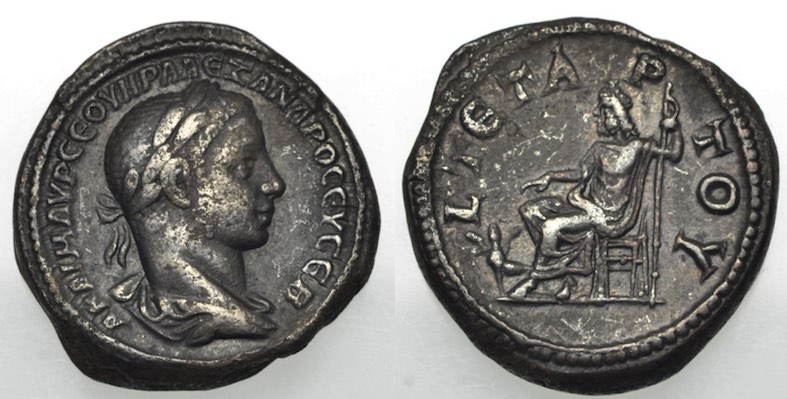
Severus Alexander, Roman style Alexandrian tetradrachm
Year 4 = 224/5
with the same obverse legend as above
and, again, Serapis seated with Kerberos at his feet
and with year written
L TETAPTOY (year four)
Only the date is different from the year-5 type.

Severus Alexander, Roman style Alexandrian tetradrachm
Year 7 = 227/8
with the same obverse legend as above
and, again, Serapis seated with Kerberos at his feet
and with year written
L EBΔOMOY (Year seven)
Only the date is different from the year-5 type.
The most interesting type has Julia Mamaea, his mother, on the reverse.

Severus Alexander, Roman style Alexandria tetradrachm
28-25 mm. 13.89 grams. Year 5
(obverse legend as above) A KAI M AVP CEOVHR AΛEΞANΔPOC EVCEB
L ΠEMΠTOY MAMEA CEB, bust of his mother Julia Mamaea right
Fifth year. Mamaea Augusta
Sear II 8134.
Year 5 under Elagabal. The third type of "year 5" coins refer to the short period when Severus Alexander was Caesar under Elagabalus. Imperial coins from that period are rare and relatively expensive.
 Denarius. 20-18 mm.
Denarius. 20-18 mm.
Severus Alexander as Caesar.
M AVR ALEXANDER CAES
without "IMP" or "AVG". Struck July 10, 221 to March 222.
Note: He is not yet "SEVERUS".
Bust right with bare head
PIETAS AVG, priestly implements.
RIC 3, page 70. BMC (Elagabalus) 266, page 571.
This was struck at the time of the year-5-as-Caesar coins at Alexandria.
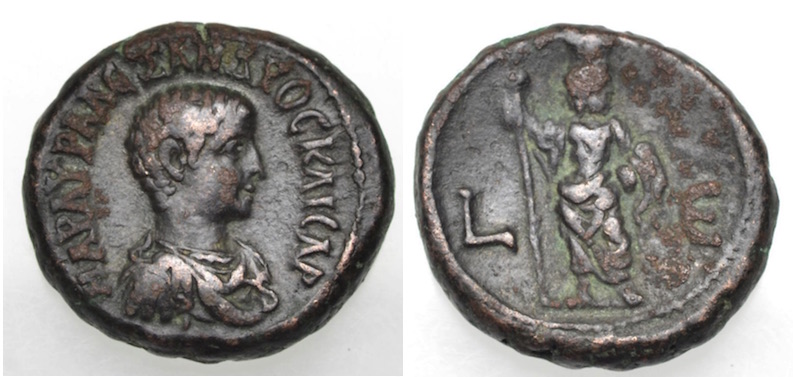
Severus Alexander as Caesar, year 5 of Elagabalus
MAP AYP AΛEΞANΔPOC KAICAP [= Caesar]
MARcus AURelius ALEXANDRUS CAESAR
Bare-headed bust right
L E for year 5, AD 221/2. Serapis standing front, head right, holding scepter.
23 mm. 13.94 grams. Emmett 3082.
"I find the metal composition argument pretty convincing that they were not only produced by Roman die engravers, but in fact struck in Rome and taken to Egypt. Why, though?
"Here's a thought. As you know, the Egyptian economy was a closed one, whereby the Roman provincial coinage made there was only used for local transactions, and not for cross-border transactions. So if the Imperial government in Rome decided to send local-style coinage, it may have been because they wanted that money to be used only locally.
"There could be a number of reasons they'd want to do this. Just an example: One occasion when funds would be sent would be when a new governor (or procurator), then living in Rome, was appointed and sent to Egypt... with a substantial packet of funds, normally. Perhaps they were mindful of that governor using the money to exert undue influence in neighbouring Syria, for example. Giving him the money in local coinage (rather than aurei and denarii) would make that more difficult. (Interestingly: it seems a governor of Egypt, one Epagathus, was executed in 224 or 225! Perhaps a lesson was learned, and the year 4 tets were produced for his replacement? Pure speculation, of course; there are probably plenty of other reasons why only locally-spendable coinage might be sent. Still, kind of intriguing.)"
Other Sources (see references below): "Roman style" tetradrachms are distinguished by 1) portrait style (obviously), but apparently also by 2) spelled-out dates, and 3) larger diameters. The second and third criteria are useful when working with Emmett and Milne, both of which do not have photos.
For each emperor Emmett lists coins by reverse type and gives the years each type was issued (and an estimate of the rarity of that type that year). For example, for year 5 of Severus Alexander, the reverse "Serapis seated left on throne, holds sceptre, Kerberos" (the type above, for year 5) was issued in years 4, 5, 7, 8, 10, 11, and 12 and it is very rare for all but years 4, 5, and 7. Are coins of those later years of Roman style with spelled-out year? We can't tell. Milne has "Serapis standing, holds sceptre" for years 4, 5, and 7. Are they all of Roman style? We can't tell. For example, Burnett and Craddock illustrate year 5 coins with reverse type the head of Serapis in both Roman style with spelled-out year 5 and Alexandrian style with LE. They look quite different but are not distinguished in Emmett.
The coins in Milne are not photographed so it is not possible to tell from photographs which ones are of "Roman style." However he does list weights, diameters, and legends. Legends and diameters are enough to identify the coins of Roman style. Here is what he has. Milne lists 34 coins of Severus Alexander from year 5 as Augustus, including 4 with obverses of Julia Mamaea. Eight have the spelled-out legend and 26 mm diameter. Two of those have a bust of Julia Mamaea on the reverse (they are two-headed coins, legend LΠEMΠTOY MAMEA CEB [year 5, Mamaea, Augusta])) and five have Serapis standing (like the first coin) and 1 seated (like the fifth coin). The other year-5 coins are typically 23 mm. Without photos it is impossible to be sure, but those are presumably not of Roman style. Milne has 29 coins of year 4, of which 4 have obverses of Julia Mamaea and 2 have the spelled-out year with large diameter, presumably of Roman style. None of the 31 year-6 coins (3 with obverses of Orbiana) have the spelled-out legend. Milne has 13 coins from year 7, 2 of Mamaea and 1 with the spelled-out date, although that one is only 24.5 mm.
Giessen has all the coins in the collection photographed. It has eight coins from year 4, two of which are of Roman style. It has twelve of year 5, six of Roman style, including one with reverse the head of Zeus Ammon and one with reverse the bust of Julia Mamaea. For year 7 Giessen has five pieces, one in Roman style with the bust of Julia Mamaea. None of the other years have any coins of Roman style.
Forschner has all coins photographed. It has 70 coins issued under Severus Alexander, including 1 of Orbiana alone and 16 of Julia Mamaea alone. There are 3 coins of year 4, none of Roman style, 6 of year 5, 3 of Roman style (2 Serapis standing, 1 seated), and 1 of year 7, not of Roman style. None of the other years have any coins of Roman style.
Curtis has c. 1200 coin photographs reproduced from sale catalogs. They are in the sale catalog order with the sale catalog numbering, so any given type might be photographed (or not) in five different places. It has 50 coins of Severus Alexander (41 from the Aiello Collection) of which 3 are of Roman style, 2 with Julia Mamaea (years 4 and 5) and one with Serapis seated (year 4).
Sale catalogs with extensive selections of coins of Roman Alexandria are discussed below in the references.
| Reverse | Year(s) | Reference with photograph, ID number (year) |
| Serapis standing | 4, 5, 7 | Geissen 2434 (5), Forschner 845-6 (5) |
| Serapis seated | 4, 5, 7 | Geissen 2425 (4), 2435-7 (5), Forschner 847 (5), Curtis C312 (4) |
| Bust of Mamaea | 4, 5, 7 | Geissen 2424 (4), 2433 (5), 2447 (7), Sear 8134 (5), Curtis C311 (4), D422 (5) |
| Bust of Zeus Ammon | 4, 5 | Burnett 4 (4), Geissen 2432 (5), |
Conclusion: "Year 5" tetradrachms for Alexandria in the name of Severus Alexander come in three categories
1) the usual Alexandrian style, issued from Alexandria using his regnal year date written "LE",
2) "Roman style", larger, with regnal year spelled out "LΠEMΠTOY", and struck at the Rome mint for use in Egypt,
and
3) the usual Alexandrian style, issued from Alexandria in year 5 of Elagabalus when Severus Alexander was Caesar.
Similar "Roman style" coins were also issued in years 4 and 7, but not other years. There are only a few occasions when the Rome mint struck coins in Greek as if they were struck at a regional mint. The reason the Rome mint got involved in producing coins for circulation in Egypt in these years is obscure.
Emmett, Keith. Alexandrian Coins. 2001. [This is intended to be a complete listing of Alexandrian types, organized by ruler and type, with a table indicating which regnal years each type was issued. It has types illustrated by line drawings and each ruler is illustrated by at least one photographed coin. However, the list does not distinguish size or style, so it is not possible to look an an entry and know if that Emmett number refers to a larger, Roman-style, coin.]
Milne, J. G. Catalogue of Coins of Alexandrian Coins. 1927. [This is a list of the coins in the Ashmolean Museum, Oxford, which were mostly Milne's coins. The collection was so large it served as a nearly-complete list before Emmett. It lists individual coins and gives their diameters, weights, types, and legends. It does not illustrate both sides of coins. It has seven page plates illustrating casts of representative reverse types only.]
Giessen, Angelo. Katalog Alexandrinischer Kaisermunzen der Sammlung des Instituts fur Altertumskunde der Universitat zu Koln, in 5 volumes. (Volume 3 has Severus Alexander.) [Sear calls this "Cologne".] In German. [3627 coins photographed and described with extensive cross-references. Also, the obverse legends are all expanded (unfortunately, in lower-case Greek). It is organized by year (not by type, as is Emmett)
Forschner, Gielsa. Die Munzen der Romischen Kaiser in Alexandrien, Die Bestande des Munzkabinetts, Historisches Museum Frankfort am Main. 1987. [1400 coins photographed. Organized by emperor and year.]
Curtis, James. Tetradrachms of Roman Egypt. 1990 Durst reprint. The orignal edition did not have photos and this has c. 1200 coin photos from sale catalogs of Empire Coins (fixed price list , an unnumbered auction "The Coinage of Roman Egypt" of May 30, 1984), Classical Numismatic Auctions (now CNG, auctions 3, 4, 5, and 6, all 1989-1990), and Malloy (auction XIV, The Aiello Collection, July 2, 1979), and Malter auction II ("The Coinage of Ancient Egypt," Feb. 23-24, 1978). The photos and their catalog descriptions have not been edited to exclude denominations other than tetradrachms. An index by ruler at the end locates coins scattered through five distinct series of plates.
BMC Greek, Alexandria, by R. S. Poole. [This volume does not illustrate both sides of coins, only reverse types (and a few portraits). Also it does not give diameters or weights, so it is not useful for distinguishing Roman style coins, except by legend.]
RIC IV, part II. [For imperial coins only, not for coins of Alexandria]
Sear, David. Roman Coins and Their Values II. [This includes many types from Alexandria. It lists representative coins for most reverse types, but does not attempt to list each year as well.]
Burnett, A. and Andrew Craddock, "Rome and Alexandria: The minting of Egyptian tetradrachms under Severus Alexander" ANS Museum Notes 28, pages 109-118 and plate 20. [Illustrates 9 pieces of Severus Alexander from Alexandria, 3 of Roman style (1 year 4 with head of Serapis, 1 year 5 with Serapis seated, and 1 year 7 with Serapis standing).
Sale catalogs
Munz Zentrum auction 52 (1984, Nov. 12) 1370 coins from Alexandria, 30 of Severus Alexander including 2 as Caesar and 4 of Roman style (1 Serapis seated, year 4, 1seated and 1 standing, year 5, and 1 reverse bust of Mamaea, year 5).
Munzenhandlung Gilles Blancon fixed-price list 31, 1999-2000. 1380 coins of Roman Egypt, well-photographed. Most, but not all, photographed on 42 large page plates. 46 of SA, 4 of Roman style. (1 Serapis standing and 1 seated of year 5, 1 seated of year 7, and 1 with Mamaea, not pictured but noted as of Roman style)
Empire "Winter 1987 sale" has 542 coins of Roman Egypt, including 10 of Severus Alexander including 3 as Caesar, and 1 of Roman style (Serapis seated, year 5)
Malloy auction XIV (1979, July 2) "John Aiello Collection of Roman Egyptian Coins" 788 coins of Roman Egypt among 1375 lots. [Mostly low value and low quality photographs] 38 pieces for Severus Alexander, including 1 with reverse of Mamaea (year 5), 2 of year 5 Serapis standing, and 1 of year 7 Serapis seated. [Photos reproduced in Curtis.]
M&M Deutschland auction 12 (2003, April 11) "Sammlung Righetti, Part 1, Egypt." 733 ancients among 1228 on 35 ppl among 61, + 2 of enlargements. 122 G (including 58 Corinth Pegasi), 158 RP, 23 RR, 85 RI, 283 Roman Egypt, including many drachms).
Roman Egypt (283, including many drachms), Corinth Pegasi (58).
283 coins of Roman Egypt. Among 6 tetradrachms of Severus Alexander, 3 are of Roman style (1 Serapis seated and 1 standing, year 5, and 1 standing, year 7).
CNG XII (1990, Sept. 26) has 307 coins of Roman Egypt, but none of SA.
Myers, Robert, fixed-price catalog "Tetradrachms of Roman Egypt" (uncertain date, late 1970s?) has 136 pieces, 2 of Severus Alexander, including 1 as Caesar and none of Roman style
Empire Coins auction "The Coinage of Roman Egypt" (1984, May 30) 139 pieces, 1 of Severus Alexander, not Roman style. [Photos reproduced in Curtis.]
Historical Coin Review, Spring 1988, Victor England fixed price list. 119 pieces, 9 of Severus Alexander including 2 of Roman style (both year 5, 1 Serapis standing, 1 seated)
Comment: Sale catalogs with large collections of coins of Roman Alexandria presumably have some of the finest examples, but the examples of Roman-style coins in these catalogs are generally VF. Some are worse, some have encrustations, and few are better.
Go to the main Table of Contents page.
This page first posted May 18, 2017.